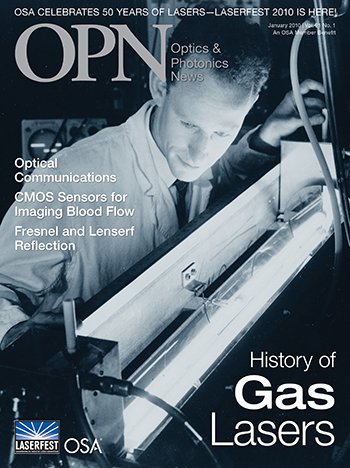
January 2010 Issue
Feature Articles
A Snapshot of Optical Communications
Optical communications is advancing at nearly the speed of light. This preview of March’s Optical Fiber Conference/National Fiber Optic Engineers Conference describes current trends, including the increasing role of wireless technologies and the continued integration of optics with other networking layers.
by OFC/NFOEC chairsCMOS Sensors for Imaging Blood Flow
Laser Doppler flowmetry is useful for monitoring blood flow, but the slow scanning speed can introduce motion artifacts and make detection of rapid changes impossible. Instruments that incorporate CMOS technology may enable real-time imaging of microcirculation.
by Steve Morgan, Barrie Hayes-Gill and John CroweFresnel Reflection, Lenserf Reflection and Evanescent Gain
Recent investigations into Fresnel reflection and total internal reflection have led to conflicting results when the evanescent medium is “gainy” rather than lossless or lossy. This controversy can be resolved by introducing the much less well known concept of Lenserf reflection—an idea put forward by the illustrious Dr. Tung Inn Cheek.
by Anthony SiegmanHistory of Gas Lasers, Part 1—Continuous Wave Gas Lasers
In this first of a two-part series, Jeff Hecht relives the excitement that accompanied the development of the first gas lasers to generate continuous-wave beams.
by Jeff HechtDepartments and Columns
Social Media Illuminate Optics
If you believe that online tools like Facebook and Twitter are just for college kids and celebrities, think again. Social media sites are revolutionizing the way in which busy professionals—including optical scientists—get their news, network, and learn about industry-specific events.
Most labs rely on just a handful of lasers, but an estimated 15,000 types have been developed over the years. Here, Steve Wilk explores the lasers that have been consigned to the scrapheap of history.
Researchers have made a Raman fiber laser that is longer—if stretched out—than the distance from San Francisco to San Diego, and three times the length of the next-longest laser reported in 2006.
Early Profiles in Optics: Charles E. Mendenhall
Charles E. Mendenhall, an early vice president of OSA, was known for both his brilliant insight into black-body radiation and his generous spirit as a teacher and mentor.
Eyeing Shrimp Eyes for Manipulating Polarization
Researchers have found that a certain kind of shrimp not only sees polarized light, but has cells in its eyes that can manipulate it more efficiently than our best technology.
Using laser light to program memories.
Also in this Issue


![Manual probe system with needles for test of semiconductor on silicon wafer. [A. Morozov / Getty]](https://opnmedia.blob.core.windows.net/$web/opn/media/images/articles/2025/1125/departments/202511-cover-web.jpg?ext=.jpg)
![Researcher Clara Saraceno in the lab. [Image by Carsten Behler Photography]](https://opnmedia.blob.core.windows.net/$web/opn/media/images/articles/2025/1025/departments/202510-cover-web.jpg?ext=.jpg)
